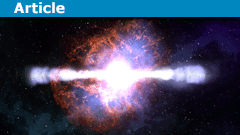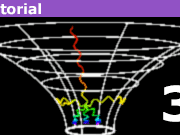What are the Fates of Massive Stars
Table of Contents
Key Points
- Stars are born in primordial nebulae, gaseous molecular clouds on the spiral arms of galaxies
- Stars smaller than 1.4 suns will settle into a white dwarf and eventually become a black dwarf
- Stars greater than 1.4 suns will undergo a much more violent death, as their nuclear fuel is exhausted and their core collapses in a catastrophic event
- This collapse releases energy equivalent to 10 times the output energy of the star during its entire lifetime
- The energy leaves in the form of a massive explosion called a supernova 6. Neutrinos are formed when a proton fuses with an electron during the rapid collapse of the star
- The remaining energy rebounds from the newly formed neutron core and radiates outward
- Neutron stars are generally between 10 and 20 km across with densities reaching 1017 kg/m3
- Pulsars are spinning neutron stars that generate high magnetic fields and become lighthouse–like beacons emitting radio waves or other types of electromagnetic radiation
- Neutron stars may have a solid core and possibly a superfluid composed of free neutrons
- Neutron stars have an upper limit mass somewhere between 2 and 3 solar masses
- Neutron stars greater than 4 solar masses will undergo complete gravitational collapse and form a black hole, a dimensionless point of infinite density with a region called the event horizon, not even light can escape
Introduction
Deep in the vastness of space, beyond our solar system, stars are born in primordial nebulae, gaseous molecular clouds on the spiral arms of galaxies extending across the heavens. Intense gravitational forces compress the cloud causing temperature and pressure to increase immensely. At critical temperatures and pressures within the nebula, the miracle of life occurs. Thermonuclear reactions erupt violently fusing hydrogen to helium. Within this gaseous womb, a protostar is born, and just as there is new life in the universe there is also death…
Fueled by nuclear reactions the star lives a solitary life emitting its light into the blackness of space for millions of years. For those stars smaller than 1.4 suns they will die a peaceful death as their nuclear fuel is exhausted and their core balances out against gravity’s compressive force via electron degeneracy pressure becoming a white dwarf star. After billions of years, a white dwarf’s thermal energy will be exhausted and it radiates its final glow as it dies becoming a non-luminous black dwarf.
White Dwarfs in the Globular Cluster M4Photo taken by The Hubble Space Telescope
What is the fate of a star greater than 1.4 suns? It will not settle into a white dwarf and eventually become a black dwarf. Will it be able to balance out against the force of gravity? A much more violent death awaits those massive stars.
Massive Stars
For stars much greater than 1.4 suns death is violent and chaotic. Massive stars burn much hotter and brighter than the smaller stars that enter the stellar graveyard as black dwarfs. In the core of these massive stars, nuclear forces acting over minute distances on the order of 10^13 cm cause intense nuclear fusion reactions. The nuclei of these elements within the core of the star electrically repel each other. Extremely high temperatures are needed to overcome this repulsion and these high temperatures along with extreme internal pressures provide the energy needed to ignite nuclear reactions. These massive stars are powered by a sequence of nuclear reactions that produce heavier and heavier elements. As the nuclear fuel is exhausted heavier elements are produced; hydrogen fuses with helium, helium fuses with carbon and oxygen, then carbon and oxygen fuses with neon and magnesium, this is followed by fusion of those elements into silicon and sulfur. Each fusion cycle releases energy that balances against the inward compression of the star due to the gravitational force. However, as this nuclear fuel is used it settles down into a state where fusion can no longer occur. The final remnants of the last fusion cycle are iron. However, no nuclear reaction can release energy from the iron, signaling the end of the road for the massive star. Without the energy of nuclear fusion reactions, the star cannot balance its outward force caused by the nuclear reactions with the inward-directed force of gravity.
The massive star now has an iron core that exceeds Chandrasekhar’s limit of 1.4 suns, the star cannot reach equilibrium as the white dwarf did. There is no nuclear fuel left to burn. Gravity attacks, the star shudders, and the core collapse in a catastrophic event as it reaches the density of an atomic nucleus about a million billion times the density of water. The nuclei are ripped apart so that a soup of densely packed particles remains. This collapse releases energy that is equivalent to ten times the output energy of the star during its entire lifetime. The density increases more and more and gravity’s inward compression becomes so great that the protons and electrons are fused together forming neutrons. Under normal circumstances, a free neutron would decay into a proton via the exchange of an intermediate vector boson that decays into an electron and an anti-electron neutrino. This process is commonly called beta decay. However, gravity’s crushing hold will not allow this. The density is so great and the neutrons are packed so tightly that the Pauli Exclusion Principle will not allow any electrons to be created during the decay of a neutron into a proton. The core is now tightly packed with about 1057 neutrons. A single thimble full of neutron stars material would weigh nearly 100 million tons. The energy used up in the collapse of the core is only about 10% of the total energy being supplied by gravity. The other 90% of the energy leaves in the form of a massive explosion called a supernova.
Supernovae
A core-collapse supernova occurs when the stars collapse inward due to the gravitational force and the energy rebounds off the core and blows the outer layers of the star into space causing a massive explosion. About 90% of the energy of the supernova is carried away from the star by subatomic particles called neutrinos. These neutrinos are formed when a proton fuses with an electron. During the rapid collapse of the star intense energies cause the nuclei to be spilt into its elementary particle components, electrons protons, and neutrons. The collapse accelerates causing the fusion of protons with electrons which intern releases the neutrinos that are observed during supernovae explosions. This process is called the neutronization of the core. These neutrinos rarely interact with matter and are extremely lightweight particles. The remaining energy rebounds from the newly formed neutron core and radiates outward. This other 10% of the energy of the supernovae triggers the massive explosion that blows off the layers of the star. On February 23, 1987 supernova 1987A was observed a mere 170,000 light-years away in the Large Magellanic Cloud. The significance of this supernova was that it was the first time a star had been observed before and after the supernova explosion. The star was on the order of 20 solar masses. The observations made by scientists largely agreed with the theoretical predictions of supernova theory at the time. One such successful prediction was the observation of neutrinos at the Kamiokande II detector in Japan and the IMB detector in Cleveland Ohio. Both of these detectors registered neutrinos a few hours before optical telescopes could observe the shock wave erupt over the star’s surface. This neutrino burst lasted for approximately one minute. That event marked the first detection of neutrinos from an astronomical body. On that day it is estimated that about 100 trillion neutrinos from supernova 1987A passed through each person’s body may be even reacting with a nuclei inside you. The star explodes sending debris hurling into interstellar space. But is the violent supernova the final death of the star, what remains after the explosion? A small ultra-compressed high-density core remains; it is called a neutron star.
Pulsars
Neutron stars are generally between 10 and 20 km across with densities reaching 1017 kg/m3, that is1015 times denser than ordinary solids. In 1967 Jocelyn Bell at Cambridge University’s Mullard Radio Observatory found a source emitting regular pulses of radio waves every 1.34 seconds. These uniform emissions were highly accurate. What were these sources? They are pulsars, spinning neutron stars that generate high magnetic fields and become lighthouse-like beacons emitting radio waves or other types of electromagnetic radiation. The spinning of the neutron star generates an electric current which accelerates electrons about the star. The star also has two “hot spots” that emit radiation in lighthouse-like patterns. These spots are located near the star’s magnetic poles where charged particles such as electrons and positrons are accelerated to nearly half the speed of light by the star’s intense rotating magnetic field. The following diagram shows the lighthouse model for pulsars.
The blue light within the Crab Nebula shown on the previous page is due to synchrotron radiation. Charged particles moving at nearly half the speed of light through the pulsar’s magnetic field travel on helixial trajectories cantered about the magnetic field lines release energy in the form of synchrotron radiation.
Pulsars also pulse X-Rays, as this is visible in the picture above that was taken by the Chandra X-ray observatory. The swirling nature of the X-Rays is testimony to the rotating magnetic field of the pulsar. Also, note the streams of X–Rays along the magnetic axis of the star. By tracing those beams of radiation back into the center one can see that the neutron star lies in the middle of all the outflowing swirling radiation.
Neutron Stars
What does a neutron star look like up close, and what is the internal structure of such a highly dense object? The outer layer of the star would largely be composed of iron, krypton, and germanium, possibly other highly neutron-rich elements, arranged in a lattice structure, that could be formed by fusion reactions during the supernova explosion. Many of the isotopes of the various elements that make up the neutron star and the free neutrons themselves would undergo beat decay as mentioned earlier. However, the Pauli Exclusion Principle forbids decay because there are no unoccupied quantum states for the electrons to go to. Below the crust, density increases and nears 1014 grams per cubic centimeter. This area would largely be composed of free neutrons. Certain models predict that the free neutrons would behave as a superfluid analogous to Bose-Einstein Condensates. Superfluids have nearly zero internal viscosity and in the case of a neutron star would most likely be swirling in a vortex-like motion within the star. The neutron star may also have a solid core but it has not been verified. Earlier this year astronomers discovered quark stars that have greater densities than neutron stars. They are composed of matter in the free-quark state that may have been the result of further gravitational collapse. These quark stars may occur only under certain intense temperature and pressure situations. Currently, astrophysicists and astronomers are at work trying to understand this new type of star. The properties of quark stars are similar to that of neutron stars and it is assumed that the stellar death of a quark star would be similar to that of a neutron star. The magnetic fields of pulsar and neutron stars are also extremely strong. They are a million times stronger than the strongest fields created in laboratories. Since these neutron stars are so dense and occupy a small region of space in comparison to other stars they have extremely large masses. The more mass means the greater the force of gravity that the object exerts on another object. The force of gravity on the smooth surface of a neutron star would be 1012 times greater than the force of gravity on earth. Such high gravitational force would correspond to escape velocities approaching half the speed of light. Neutron stars generally have an upper limit mass somewhere between 2 and 3 solar masses. But what happens to neutron stars greater than approximately 4 solar masses?
Black Holes
These stellar objects are so heavy that they undergo complete gravitational collapse. No amount of internal fusion can hold up against the compressive force of gravity on such a heavy object. They may become supernovas and then neutron stars but gravity will ultimately succeed. The neutron stars can hold up against gravity if it is less than 3 solar masses. However, if it is greater than the upper limit it will collapse inward towards a singularity. A singularity is a dimensionless point of infinite density. All the mass of the star is crushed inward and the gravitational pull due to this infinitely dense point particle becomes so strong that beyond a region called the event horizon, not even light can escape. The result of the total gravitational collapse of star results in the formation of a black hole.
Conclusion
Massive stars have far different deaths than their lightweight brethren. They may explode violently emitting showers of neutrinos and shedding their outer core into interstellar space. Then the stars will become highly dense neutron stars or perhaps it will be rotating, in which case it would become a pulsar, a radio wave lighthouse beacon at the center of a nebulous cloud; similar to the pulsar at the center of the Crab Nebula. Or perhaps the ultimate fate lies in store for the star. It may undergo complete gravitational collapse, the inevitable inward compression, and the birth of a black hole, and the formation of a singularity. Perhaps the hope of life is not completely lost during the death of these cosmic furnaces. The universe may have been created from a singularity. Other theories suggest our universe may reside within a giant black hole, and recent evidence suggests that there may be a massive black hole at the center of our galaxy that essentially holds everything in place. So in a universe as vast as ours with so many stellar phenomena the death of a star might mean the birth of a galaxy or life as we know it.
Sources:
Begelman, Rees. Gravity’s Fatal Attraction: Black Holes in the Universe. New York: Scientific American Library. 1996
Chaisson, McMillan. Astronomy Today. 4th ed. New Jersey: Prentice Hall Inc. 2002
I have a BS in Information Sciences from UW-Milwaukee. I’ve helped manage Physics Forums for over 22 years. I enjoy learning and discussing new scientific developments. STEM communication and policy are big interests as well. Currently a Sr. SEO Specialist at Shopify and writer at importsem.com








Leave a Reply
Want to join the discussion?Feel free to contribute!